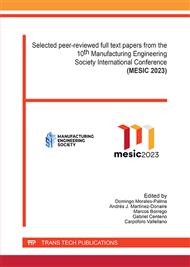p.3
p.13
p.22
p.31
p.43
p.53
p.61
p.70
Data Analytics Applied to Tool Condition Monitoring during Drilling of Hybrid Stacks in Industrial Aircraft Production Systems
Abstract:
The aviation industry is changing significantly as market demands and customer expectations evolve. Aircraft must be designed and manufactured with a future-oriented production system that incorporates computational intelligence, connectivity, and decentralization to ensure the highest levels of quality and performance. By leveraging these technologies, real-time monitoring and continuous process improvement can be achieved through collecting and processing massive amounts of data, accompanied by more sophisticated communication protocols. Among the many operations involved in component assembly, drilling processes are particularly relevant in the aeronautical industry. When drilling airframe components, hybrid joints are generated by combining stacks of various materials, such as titanium and Carbon Fiber-Reinforced Plastic (CFRP). Due to the complexity of drilling these hybrid stacks and the need to adhere to strict quality and safety standards, the cost-per-hole can be pretty high. Consequently, scientific studies in this area are of great interest, as they offer the potential to increase productivity and reduce costs. This research aims to investigate using spindle power consumption signals obtained directly from an industrial drilling system to monitor tool wear evolution. Signal pre-processing, feature extraction, selection, and validation are used to analyze data from two sources: the spindle power consumption signals obtained from the internal instrumentation of the machine and the cutting tool. The study focuses on automatic drilling operations carried out in hybrid stacks at an aircraft manufacturing facility, and the results show a strong correlation between power consumption and tool wear. These findings suggest the potential to develop a non-intrusive tool condition monitoring system that could be applied to other machining processes in the industry.
Info:
Periodical:
Pages:
22-30
Citation:
Online since:
October 2023
Price:
Сopyright:
© 2023 Trans Tech Publications Ltd. All Rights Reserved
Share:
Citation:



